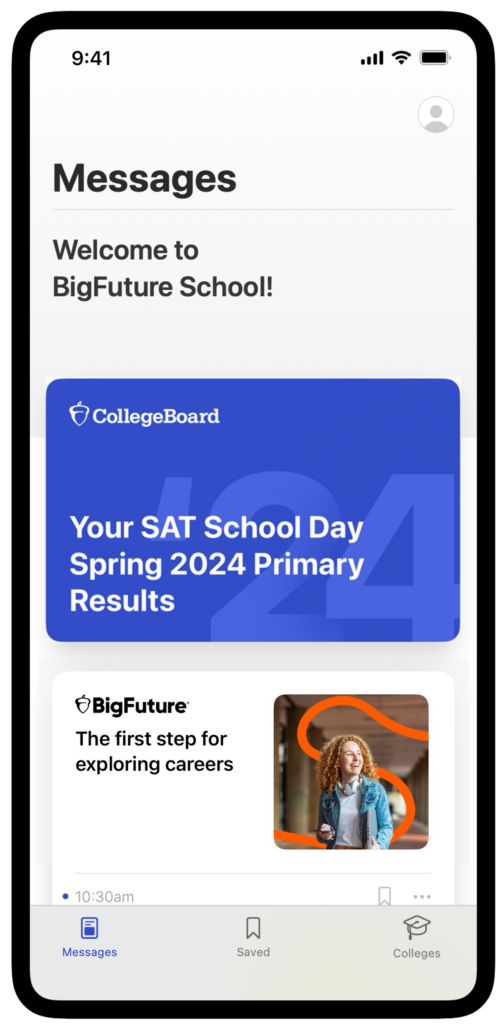Recently, high school students across the globe began navigating a new testing experience: the digital SAT®.
This important shift from paper and pencil to digital meets the needs of a generation that is most comfortable consuming information on laptops and mobile devices. In fact, 83% of test takers surveyed in fall 2023 said they had a better experience compared to the paper format. It’s hard to argue with a shorter assessment that includes assistive technologies and is offered on the same digital platform as the practice tests.
The SAT helps districts and schools meet their college and career readiness goals. And with the digital format, the assessments introduce students to more opportunities than ever before and offer increased visibility to educators and schools.
Providing Students With Career Connections
It’s never too early for students to explore career possibilities. Last year, College Board shared one way that students can start. A new addition to score reports, Career Insights Snapshot shows a list of growing careers in a student’s state needing skills like theirs.
Every career has measurable skills. College Board and subject matter expert, HumRRO, mapped these skills to careers in the O*NET database and the Math section and Reading and Writing section scores tested on the SAT Suite. Each career listed in the score report pays a living wage, is growing in their state, requires some level of postsecondary education, and connects to skills demonstrated through their SAT Suite assessments.
If students don’t like the career examples, that’s ok. The purpose of Career Insights Snapshot is to build awareness of and spark interest in career and postsecondary options. This helpful video explains how Career Insights Snapshot can help you support students with career exploration.
Encouraging Students to Plan the Moment They Get Their Scores

In addition to the Career Insights Snapshot, College Board also launched a new, student-centered resource for in-school test takers: BigFuture® School*. This mobile app puts the power to plan in students’ hands and makes it easier to access personalized college and career guidance.
How does it work? Students have the option to provide a mobile phone number during their exam set-up to access the app. The mobile number is only used to authenticate students’ information and alert them when scores are available. It is not used for any other purpose.
While a benefit of BigFuture School is that students can view their scores quickly, that isn’t the only benefit. Millions of students are using the app to explore college and career messages. The messages are curated for time of year and grade level.
Connecting Students to Nonprofit Colleges and Scholarship Programs
Most importantly, BigFuture School puts students’ privacy first, with no disclosure of their personal information as a part of ConnectionsTM.
Where available**, students can opt into Connections to receive messages from nonprofit colleges, scholarship programs, and educational organizations interested in students like them. Students can discover hundreds of institutions and get to decide if and when to contact these institutions directly.
Research shows that on average, students who hear from colleges are 25% more likely to enroll and 31% more likely to graduate on time. Those gains are greater for Black and Hispanic students.
With an evolving college landscape, we need all students—especially those historically underrepresented on campuses—to have the information and access to make informed choices.
Keeping Educators in the Know to Support Students
To help educators engage in more meaningful talks with their students about what’s next, educators with access to our K–12 reporting portal will have visibility to certain student activities in the BigFuture School app. For example, they’ll be able to see if a student checked their score, looked at the Career Insights Snapshot, or received messages from colleges.
Educators’ ability to understand where students are in their future planning journey, see an objective measure of their abilities, and identify learning gaps that can guide classroom instruction and additional support have not changed. So, while the digital experience is new, the value to students, schools, and communities remains: helping all students to own their future.
*Available to domestic, in-school test takers of the PSATTM 10, PSAT/NMSQT®, and SAT School Day assessments who are 13 and older.
**States, districts, and schools can choose not to offer Connections to students.
Sponsored Content Disclaimer:
Sponsored Content in Partnership With NASSP
NASSP allows select groups to share information and thought leadership with our program audiences.

